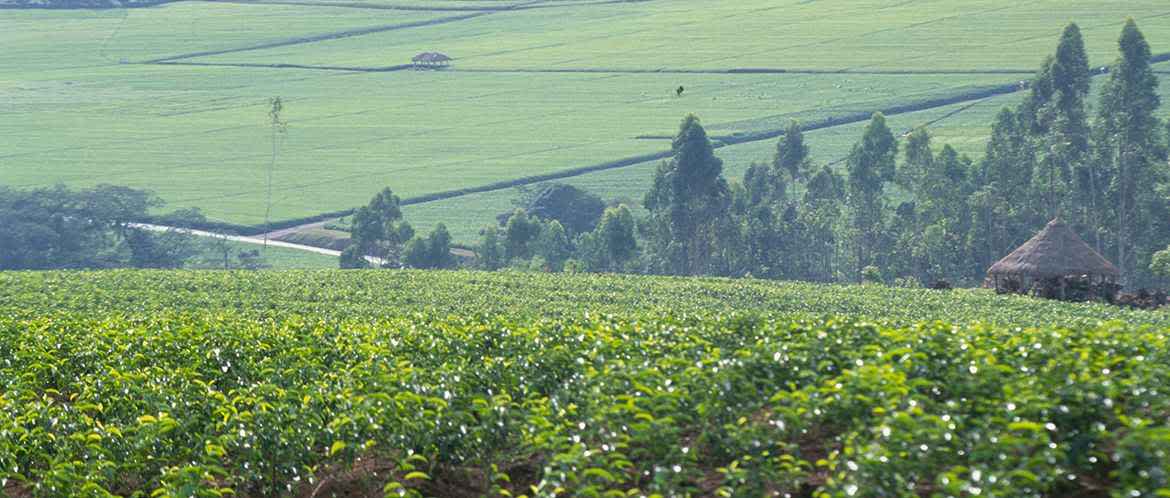Each cup of Red Rose starts its journey in the rich, equatorial soils of our vast tea gardens in Kericho, Kenya, located on the western edge of the Great Rift Valley. Our plantation is bordered by lush, indigenous forests that are home to an abundance of flora and fauna. We consider it our duty not only to protect and maintain these natural ecosystems, but also to bring balance back to damaged ones. We grow our tea with the utmost respect for the local environment and are committed to sustainable agricultural practices. Come and see the Red Rose journey in its entirety by taking the Tea Garden Tour of our Rainforest Alliance Certified™ plantations.
OUR TEA GARDENS
The Red Rose tea gardens are located in Kericho, Kenya, on the western edge of the Great Rift Valley, where the combination of temperature, sunlight, rainfall, high altitudes, and proximity to the equator is ideal for producing high-quality tea all year long. We are committed to ensuring the health and well-being of our workers, and to respecting the environment through sustainable agricultural practices. In that regard, we’re proud to announce that our Kericho tea gardens are Rainforest Alliance Certified™. Our tea gardens cover more than 11,000 hectares and produce approximately 20,000 tonnes of tea annually.
THE TEA FIELDS
Tea harvesting is meticulous work and requires considerable skill. Expert tea harvesters, called pluckers, learn to identify the exact moment at which tea leaves should be plucked. This is important to ensure that only the tenderest leaves are picked so that only high-quality tea is produced. The leaves are plucked in the morning, when the plants are most full of life and glistening with morning dew. The pluckers are trained to pick only the top two leaves and a bud, and to leave the older, coarser leaves so that the plant can continue its normal growing process.
THE WEIGHING STATION
The pluckers place the plucked leaves in a basket that they carry on their backs. When the basket is full, it is taken to a collection point called a weighing station, where the leaves are weighed.
THE WITHERING PROCESS
Once delivered to the factory, the fresh tea leaves are left to wither in large drying troughs set on wire mesh. The withering process usually takes place out of direct sunlight. Large fans blow air through the leaves to reduce the moisture content. The leaves are spread evenly so that maximum air flow is achieved and no heat is generated — and so that they can wither uniformly. At the end of this process, the leaves are limp and pliable, making them easy to roll.
ROLLING AND OXIDATION
The withered leaves are taken to rolling machines, where they are cut and rolled, which exposes their enzymes to air, thus beginning the oxidation process. Oxidation in tea leaves is the process by which oxygen reacts with the enzymes in the leaves and darkens the leaves. This stage is important in determining the taste of the tea, and a careful balance must be maintained: the longer the oxidation process, the more intense the flavour and strength of tea will be—but the more it will lose its complexity too. The oxidation process is monitored constantly by workers with years of experience, who closely observe the temperature of the leaves with a thermometer. When the oxidation process is complete, the tea leaves move on to the final stage: drying.
THE DRYING PROCESS
After oxidation, the leaves are dried or fired. This is done by slowly passing the leaves through hot air chambers, which evaporate all remaining moisture and turn the leaves a dark brown or black. Drying the tea leaves destroys the enzymes and stops the oxidation process, transforming the leaves into a stable product. After drying, the tea leaves must cool before they are sorted and graded. If the sorting takes place while the tea leaves are still warm, they can lose their character and aroma.
TEA BLENDING
Each lot of tea must be sampled before it is allowed to leave the factory. During sampling, the freshly manufactured tea is carefully measured out and brewed in specially designed sampling cups. Typically, the taster will swirl the tea in his or her mouth to confirm and evaluate quality of the tea. The sorted and graded tea is then shipped to a Lipton Teas and Infusions blending expert, who creates a well-balanced flavour using teas of different origins and character. This ensures that differences in quality, as well as seasonal variations, can be avoided. The golden rule of blending is to make every blend taste like the previous one to ensure that our tea drinkers always get the signature Red Rose taste that they have come to know and love.
ENJOY A PERFECT CUP OF TEA
Each cup of Red Rose starts its journey as fresh leaves plucked from tea bushes grown in the rich soils of our vast tea gardens, and slowly makes its way to your home to enrich the moments that you share with your friends and family. To learn how to brew a perfect cup of goodness, visit our article entitled The Perfect Cup — and don’t forget to browse our other articles for great ideas on how to make your teatime extra special.

